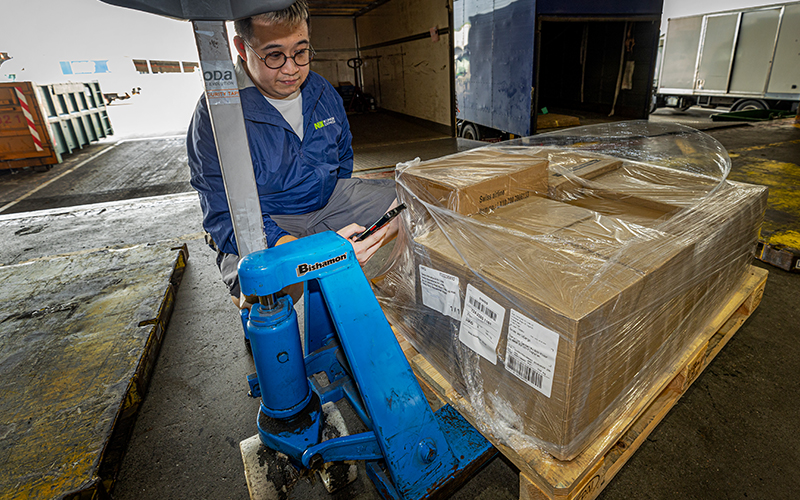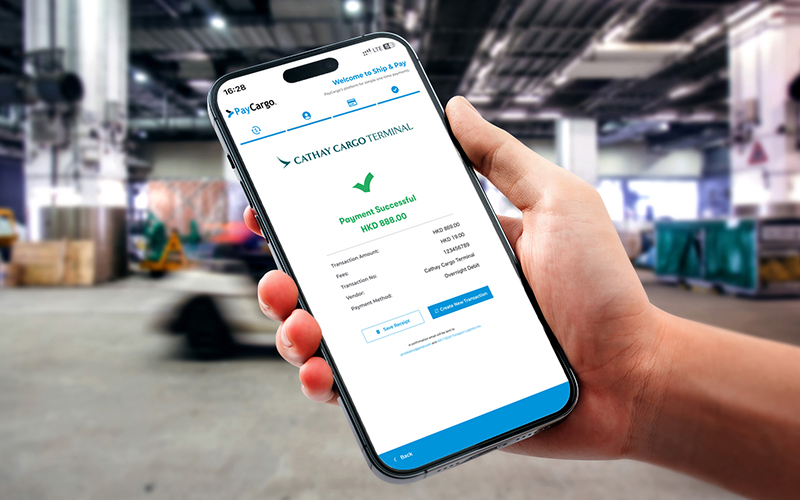While a certain amount of manual work remains inevitable when it comes to building up exports or breaking down imports at warehouses worldwide, Cathay Cargo Terminal has long been a leader in automation and digitisation, while reducing paper processes. At its heart is a highly automated material handling system and an even more advanced warehouse operating system. It has been a digital leader in Hong Kong as the first terminal to enable eAWBs, provide a mobile app for customers for empty ULD release, and adopt new CargoiQ milestones.
‘The next obvious focus for us was digitisation of the import collection process,’ says Mark Watts, Chief Operating Officer for Cathay Cargo Terminal.
That’s because the legacy and long-established industry shipment release process can be arduous for forwarders or their trucking agents. Drivers would leave their trucks in the truck park, go into the terminal with their paperwork to prove their identity, be issued with a paper shipment release form (SRF) and truck dock allocation, and then queue up and pay at the cashier. This is all before showing all the paperwork again to get their shipments released on the collection floor. This meant a lot of paperwork and quite a lot of walking between truck, terminal, dock, office and potentially the customs office too.

‘We realised that digitalising the SRF would provide much more convenience for our customers, speed up the end-to-end process, improve security and be more efficient overall. It also has an obvious benefit in terms of one of our sustainability goals, to remove as much paper from our operation as possible,’ says Watts.
But rather than build a proprietary solution solely for use at the Cathay Cargo Terminal, if the eSRF process were to bring convenience to customers, it needed to be a community solution to work across all of Hong Kong’s CTOs should they choose to support it. If not, truck drivers could end up with multiple bespoke apps, which could actually make the process more complex. Fortunately, help was at hand with the Airport Authority Hong Kong (AAHK)’s ‘HKIA Cargo Data Platform’, which enables stakeholders across the city’s air-cargo industry to connect to it via APIs, offering transparency and, through its block chain implementation, greater security.
‘Cathay Cargo Terminal was proud to be the pioneer partner with AAHK for the import module of the HKIA Cargo Data Platform’ says Watts. ‘Our teams worked hand-in-hand with the AAHK to develop this solution – in consultation with airlines, freight forwarders and government agencies – to ensure we understood customer requirements. It meant that we could bring our perspective as a CTO, that our systems were fully integrated with the solution on day one and to make sure that were no barriers to adoption by our customers.’
The new process
The result is a hand-held app, accessed by drivers through facial recognition, which eliminates queuing time and paperwork while increasing security. Additionally, the system notifies government agencies, updating them for cargo clearance readiness, approval and approval for release.
Now the eSRF can be issued to participating agents via electronic authentication, and that can be set up ahead of drivers even setting off to the terminal. The airline issues the eSRF to consignees, which enables pre-registration as well as automatic truck dock allocation. Now that the confirmation is recorded electronically, this enables a cargo release confirmation to be shown on the mobile device using facial recognition. Once on the collection floor, drivers simply show a QR code confirmation to a reader in the office to be issued with their consignments. ‘We wanted the solution to be user-friendly and intuitive, and we think it is,’ adds Watts. ‘We also have a support team ready to demonstrate the system to any truckers who may be unsure of the new technology.’

‘It’s great to see that all the effort that went into eRSF has been so well received so far by our airline customers and forwarders,’ says Watts. Since its introduction, the app has been taken up by some 30 forwarders, including some of the major ones such as Nippon Express, Dimerco and DHL Global Forwarding.
The next phase – adding e-payments to the scheme
Adding an e-payment option was next on the agenda, as it would square the circle for Cathay Cargo Terminal in having a totally digital collection and payment platform.
Traditionally, Hong Kong forwarding companies have divided between those with a line of credit with terminals, and those that use cash. While Cathay Cargo Terminal has always offered the option to have a credit arrangements, this is not something that suits every forwarder.
Interestingly, since the Cathay Cargo Terminal in Dongguan started receiving imports, all payments have been collected electronically using the big e-payment providers Alipay, WeChat Pay and Union Pay. ‘This kind of e-payment is very common on the Chinese Mainland, but less so in Hong Kong,’ says Watts. ‘We were looking for a more tailored solution towards the cargo market here, especially one that many of our global forwarders would already be familiar with, so as to drive e-payments in the Hong Kong market’
After an RFP, PayCargo was selected as Cathay Cargo Terminal’s e-payment partner. ‘PayCargo ticked all the boxes for us in terms of user friendliness, market acceptance and security, both in terms of cybersecurity and finance,’ says Watts.

There are many advantages for forwarders because there is time, money and admin in ensuring that drivers have cash, not to mention the security issues. Similarly, it requires admin and fees to organise credit card facilities for drivers. ‘We’re incentivising people to move over to e-payments and we’ve set ourselves quite ambitious targets in terms of that and eSRFs over the coming years because we really want to drive everyone to adopt this new technology,’ says Watts.
The next step will be to integrate this new e-payment solution more fully with the HKIA Cargo Data Platform. ‘We have many ideas for further enhancement to make the process even better,’ says Watts. And without one piece of paper!









